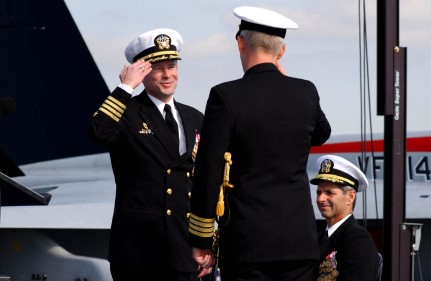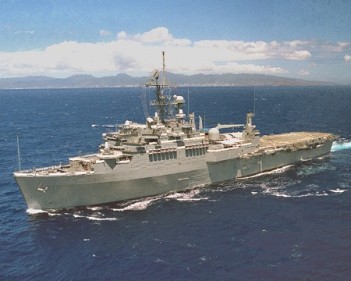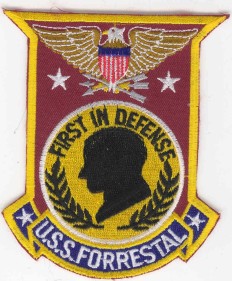
Then-Captain Ted N. Branch at the Change of Command in USS Nimitz (CVN-68). Photo USN).
Rear Admiral- soon to be Vice Admiral- “Twig” Branch is a great guy, emblematic of a class of American with a tradition of military service. He is trim and fit and smart, and he has Tom Wolf’s Right Stuff in spades.
He hails from Long Beach, Mississippi, on the little sliver of the Magnolia State that fronts the Gulf, and with the long string of beaches that run from the Florida Panhandle through lower Alabama and on to Louisiana: the Red Neck Riviera.
Twig is a real Naval officer, not a 90-day wonder like me or Mac in the generations before. Twig is a ring-knocker, graduating from Annapolis in 1979 as an Ensign, heading back to the Gulf Coast for primary flight training at Pensacola, the Cradle of Naval Aviation.
To that degree, our careers had their first intersection, since I had completed the ground school phase of flight training as an Aviation Officer Candidate that was deemed necessary for officers heading for Air Intelligence jobs support Fleet tactical aviation the year before.
I was ordered to Denver, to AFAITC (I won’t bore you with explaining all the gobblety-gook acronyms) where I was indoctrinated into the mysteries of national technical means of intelligence collection and the basics of photo interpretation, and when the background investigations were complete, how SIGINT and the other exotic stuff fit in the all-source , and the selection process began. The path was well-established and the milestones plain.
We were supposed to perform well in the Fleet, go ashore and learn our trade and compete with other intelligence specialists and see if we “broke out of the pack” for positions of greater responsibility.
Rinse and repeat for nearly thirty years, and voila, a great career. Unless, of course, you got weeded out through some misstep. It happens to good people. I won’t bore you with the nature of those- you can imagine, I think.
This story is not about intelligence career paths, except that Twig’s career progression is directly related to the careers of all the fractious information communities in the Navy, from the weather-guessers through public affairs, to code-breakers and the ubiquitous intel folks who are supposed to make sense of it all.
As I mentioned yesterday, Twig is being elevated to command them all.
You might imagine there is some wailing and gnashing of teeth about that- there always is when someone gets picked and someone else is told it is time to “go home.” There is at least one exceptional officer who is, and I feel for him. I used to observe that there was only one officer who went all the way to the end of the process, the Chairman of the Joint Chiefs, and at some point everyone else was told to retire.
I knew a retired three star line officer (different service) who was deeply bitter that he had never been to be his Service’s Chief, and had a real tail-spin after a life of success. Go figure.
For me, I knew the precise moment when it was time for me to go, and it was just at the time when all this consolidation process began, when the Navy decided to end the Radio Wars between the Cryptologists and Communicators and the Intel folks.
But that has now all come to pass. One of my pals, still on active duty, notes that we may have just buried more than the earthly remains of our shipmate Admiral Mac last month. A lot more.
But anyway, Twig and I started off for the Fleet about the same time, and it being a very small universe, it is not unusual that our paths crossed down through the years, but the path to become a Vice Admiral of the Unrestricted Line is mind-boggling in its complexity.
Twig’s career path was much more intricate, with points of critical evaluation and the possibility of failure at every level. Fortunately, Twig had luck and skill, and he never failed to meet the challenge at hand. This is an up-or-out institution, for good or ill, and the point is not to be the best Attack pilot in the world- it is to be the best officer under any circumstances.
Which is not to say that luck does not have a major component. Are you a talented officer in a warfare community whose aircraft is being retired from the inventory? A Non-nuclear trained General Submarine Officer? Sorry. A brilliant officer groomed for command of a conventionally powered aircraft carrier? Sorry, we are going all nuke. Thanks for your service. Don’t let the screen door hit you in the ass on the way out.
Add in the requirements for a Joint Duty tour that came with Goldwater-Nichols and there is not enough time in the day to accomplish everything, though somehow it all has to be shoe-horned into an operational career. It is a brutal process, often leads to “ticket punching,” and is completely without sympathy.
Twig’s record of advanced education- that is mandatory, too- doesn’t tell the story. He has a master’s degree in International Relations from the Naval War College at Newport, RI. The harder one is the cram-course for deep draft command coupled with the requirement to successfully complete nuclear power school.
Only a select few officers ever have a chance to become a commanding officer of any ship, much less a nuclear powered carrier. They select about six officers a year to enter the training pipeline for that duty. Twig learned a lot about ships, nuclear power and leadership during a 20-month process that will take him all around the country. Some of the schools he will take include Nuclear Power School, Nuclear Prototype, Nuclear Reactors and Surface Warfare Officer School.
Then, command of a real ship to gain experience. In Twig’s case it was AGF-11, the famous Coronado, in whose steel belly I spent two glorious years. The Navy just torpedoed her for training and she rests at the bottom of the ocean, rest her steel.

(USS Coronado, before she became an artificial reef. Photo USN).
He got Nimitz upon successful completion of that tour, and the Public Broadcasting people did a television series on what it was like to deploy under his command. He was photogenic, and the very image of the Captain we would all like to have at sea: firm but just, smart and savvy, and able to understand the problems and needs of the thousands of Sailors in his ship.
This is what it took for Twig to get here: XO in John C. Stennis (CVN 74), CO of Coronado (AGF 11) and Nimitz (CVN 68), commander as a boot one-star of Carrier Strike Group One in Carl Vinson Strike Group. During those tours, Twig deployed from both coasts to places so far away that they met in the middle. Green Ink (combat time in his pilot’s log book) included Grenada, Lebanon, Bosnia-Herzegovina, and Iraq in a variety of operations both well and ill-considered by the National Command Authority: Urgent Fury, Earnest Will, Southern Watch, Deliberate Force, Iraqi Freedom, and a stab at humanitarian relief in Unified Response.
At the moment, Twig is AIRLANT, once a mighty assignment that has come down over the years as the Baronates of Air, Surface and Submarines were downgraded and streamlined. With his new selection, Twig will return to the OPNAV Staff where he previously had served as Director of Operations and Plans (N31), the same job held by Richmond Kelly Turner long ago.
On the resume, I challenge anyone to have bullets that include the trifecta of Ops/Plans (N31), N2 (Intel) and N6 (Communications). At least, that is, since the time of “Terrible” Turner.
That is some of the baggage that will be waiting in the outer office of N2/N6 when he gets here from Norfolk.
I first met Twig when he was doing his disassociated ship’s company tour on the good ship Forrestal, named for the former SECNAV James V. Forrestal, and the first Secretary of Defense, during which tour he felt himself compelled to hurl himself to his death from the tower of the Bethesda Naval Hospital.
In FID (“First in Defense!”) Twig was Navigator, and as a ship’s company officer, was eligible for all the myriad of watch-bills afloat and ashore.
It is the way the Navy works. There is no break in the 24-hour day of a living ship, with four or five thousand citizens and a hundred thousand pounds of steel headed somewhere with urgency, or just tied up alongside the pier in a foreign port with the Liberty Party off getting into assorted trouble.
As an intel bean-bag, I wasn’t subject to all of the watches- we were “restricted” line officers, and not eligible for command at sea, the holy grail for line officers. We intel folks were able to concentrate on one thing, or maybe better said, several sequential and directly related things. I liked my life, and always marveled at the number of things that the people who were being groomed for Big Things had to do.
At some point, most rational folks give up the struggle and concentrate on something specialized. Not Twig. He is expected to take over the portfolio of a unified SIGINT/Intel community with several major agendas he is expected to not countenance. I wish him well- the challenges he has faced before will pale in comparison with the implacable interests of the old communities.
I don’t know how this is going to work itself out. There are those who have major concerns, and others, like myself, who look back at the history and marvel that I had the chance to be a part of it.
To that end, I will take you back to a day- or a night- in the life of a ship deployed by a Navy before it turned itself inside out.

(A FID patch from the locker of fabric from former ships and squadrons. Photo Socotra.)
Copyright 2013 Vic Socotra
www.vicsocotra.com
